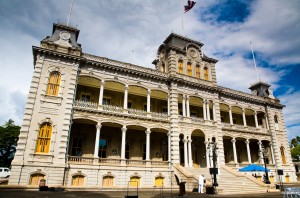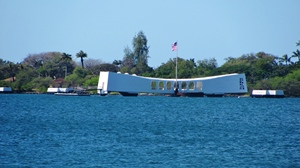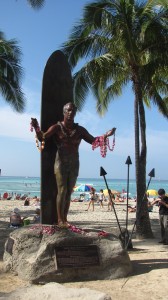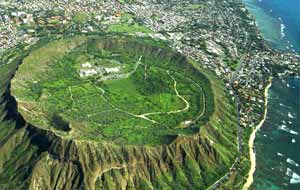Gay O’ahu Resource Directory
Discover the O’ahu Gay Scene
O’ahu also known as “the gathering place,” the third largest in size among its fellow islands in the Hawaiian chain, but it is first in population. Over 950,000 people share Oahu’s 600 square miles of mountains and beaches – and most populous of the islands in the State of Hawai’i. Almost half inhabit the bustling city of Honolulu and nearby resort town of Waikiki. Oahu is also the most visited of all the Hawaiian islands, at approximately 4.5 to 4.7 million visitors annually. From trendy hotels and TAG-approved resorts, to the best gay beach in Hawaii, and plenty of nightlife, dining and gay bars in Honolulu, Oahu is one of the top gay destinations and perfect for LGBT travel!

Waikiki Beach
O’ahu is primarily defined by the state capital of Honolulu, Pearl Harbor, and the famous beach known as Waikiki. These areas absorb tourists by thousands daily. Oahu boasts a fantastic climate, inexpensive accommodations, a large variety of shopping options, and world renown beaches – it’s fair to say the island lures in visitors from around the world. Though this may be the one fault of the island, as many are discouraged by the large crowds of Oahu and thus dismiss the island, instead visiting one of the other, less visited, islands in the chain. After all, chances are if you are staying on Oahu you too will book a room in Waikiki or Honolulu yourself. Nearly all of the island’s resorts are crammed into this small area.
Honolulu is the state’s capital and major financial center. It is also home to the main

Iolani Palace
campus of the University of Hawaii. Honolulu wasn’t always the main seat. Until 1845 the capital of the Hawaiian Kingdom was located on the island of Maui. King Kamehameha III ordered the move and the Iolani Palace was built later.
But Oahu is much more than Honolulu or Waikiki – it may well be the most beautiful of all the major islands. The Hawaii Pride Guide will help guide you to experience the beauty that is Oahu.
Oahu, is made up of two separate but overlapping volcanoes, known as a volcanic doublet. Its asymmetrical butterfly shape is formed by two mountain ranges: the Waianae Range in the west and the Ko’olau Range in the east. Slicing through the center is the flat Leilehua Plateau. Recent, geologically speaking, volcanic eruptions in the southeastern portion of the
island which formed the Diamond Head, Koko Head and Punchbowl craters can be blamed for Oahu’s uneven shape.
The eastern coast of O’ahu is hemmed in by a gorgeous mountain range and boasts three of the islands best beaches. Surprisingly, you’ll find no major accommodations here, just a few vacation homes along the quaint towns that dot the coast. The eastern region offers many visitors an escape from the busting Waikiki scene while still offering the proximity to the shopping and activities of the nearby city just a half hour drive away. The jaw-dropping Ka’a’awa Valley is also located on this side of the island. It is easily recognizable as the backdrop for the hit television series “Lost.” The island has played host to a slew of films and television shows as the current CBS hit show “Hawaii 50”.
The famous north shore of O’ahu is a surfer’s paradise, especially in the winter months when the surf is up. The monster waves and laid-back atmosphere have professional surfers flocking to Banzai Pipeline and Waimea Bay to ride some of the most killer waves in the Pacific. About an hours drive from Honolulu, this region has a surprisingly unpopulated feel to it. Many miles of beaches stretch along this portion of Oahu, making it a popular haven for those looking to relax in the sun.

USS Arizona
The western, northwestern, and central regions are where most of the island’s residents live. For the most part, there isn’t much here for the typical island visitors – just a few scattered beaches. Central Oahu does however have one of the island’s largest attractions Pearl Harbor and the U.S.S. Arizona Memorial. More than one million people a year pay their respects to the many military personnel who lost their lives during the Japanese attack. Many of these men and women and veterans of many wars are laid to rest in Punchbowl National Cemetery at Pu’owaina Crater (Punchbowl).
Beyond the sky scrapers and decidedly urban nature of the southern tip of the island is an Oahu of great natural beauty and old-time charm. For the traveler looking to experience a modern paradise, Oahu has it all – the excitement and culture of a large metropolitan city, the unspoiled beauty of tropical coastlines and verdant mountains plus everything in between.
 There are many gay beaches in Hawaii, and one of the most scenic and well-known in the world, Queen’s Surf Beach in the heart of Waikiki. The beach here draws a mostly gay & lesbian crowd, although certainly not exclusively gay. Queen’s Beach is across Kalakaua Avenue from the Honolulu Zoo and a few block from Hula’s Bar.
There are many gay beaches in Hawaii, and one of the most scenic and well-known in the world, Queen’s Surf Beach in the heart of Waikiki. The beach here draws a mostly gay & lesbian crowd, although certainly not exclusively gay. Queen’s Beach is across Kalakaua Avenue from the Honolulu Zoo and a few block from Hula’s Bar.
There are over seven gay & lesbian bars in Honolulu where you can enjoy a drink, with the open windows to enjoy the fresh ocean air. And make sure you ask your bartender about the catamaran trips as some bars offer over the weekend gay catamaran tours.
Join other world travelers on the bustling streets of cosmopolitan Honolulu. Where every you go, allow time to savor the unique character of each part of the Island, to visit the shops, dine in the local hotspots, enjoy the gay nightlife and take in the stunning vistas.
Waikiki and its famous gay beach, Queen’s Surf Beach are a top destination for surfing, sunning, sand and more. Gay Waikiki awaits you and if love the beach and the nightlife, then Honolulu on Oahu is for you. Popular, sometimes crowded yet always in vogue, the Oahu gay scene is accepting, prevalent and chock full of options for gay friendly accommodations, dining, community groups, events, gay and lesbian weddings and you might just find your favorite Hawaiian gay bar in Honolulu to boot!









